Fraser Optics S250 Image Stabilized Binoculars
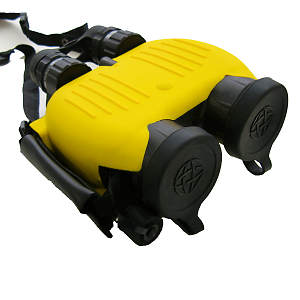 |
|
Click image to enlarge
|
|
Review Highlights
- Fraser Optics’ new S250 stabilized binocular
- Fully multi-coated MgFl glass
- Individual focus for quick target acquisition
- Superior scan rate
|
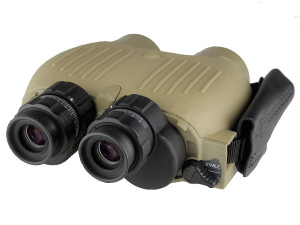 |
|
Click image to enlarge
|
Fraser Optics has the reputation for making the best image stabilized binoculars. They are the choice of the US Navy
and Coast Guard, law enforcement departments, commercial and recreational fishing captains. Even traffic reporters,
police helicopters, and search and rescue teams find them worth the invensment. When we learned Fraser was coming out
with an improved and lower-priced version, we asked for one to review. Fraser Optics obliged with a prototype just
in time for a pelagic birding trip, a perfect occasion to put their new S250 to the test.
Basics
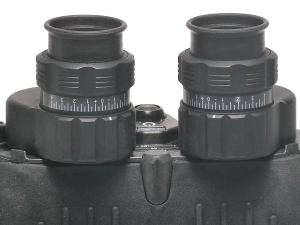 |
|
Click image to enlarge
|
The S250s are gyro-stabilized 14x41 roof prism binoculars with individual focus eyepieces. With this type of binocular,
you set the diopters separately for each eyepiece for maximum depth of field and do not need to focus them again unless
the diopters get moved or your eyesight changes. You don’t have to focus the binoculars once they are set. Not having to
worry about focus while on a moving platform, be it a ship, aircraft, or land vehicle makes viewing less of a process.
You just point and view. The downside of individual focus binoculars is that the close focus distance can be very long.
In the case of the S250, it measures about 180 feet. But you weren’t going to use them for looking at damselflies. The
S250 is for distance viewing: their primary functions are navigation and surveillance. The field of view is 222’ at
1000 yds. which is fairly wide for a 14x bino. That they work well for viewing distant wildlife or for astronomy is a bonus.
Optical Performance
And a good bonus it is. The S250 has fully multi-coated MgFl (Magnesium Fluoride) glass that deliver bright, sharp images, with
only barely perceptible chromatic aberration. We had to look very carefully to see it at all. But of course, virtually all of the
top end binoculars have similar optics. Where the Fraser Optics S250s really shine is image stabilization. With gyro-stabilized
binoculars, it can be difficult for the gyros to keep the prisms synced to the movement of the binocular. If the user scans too
fast, the prisms lag and the images have to recover to get back in sync, potentially making the user dizzy. Where the competition
has IS binoculars that lose sync above 5°/second, Fraser Optics stabilized binoculars have a maximum scan rate of 8°/second. The result
is faster scanning and faster recovery.
Our test voyage encountered a mild, but multi-directional chop, with current and wind waves crisscrossing each other.
Even leaning against a rail for balance, it was difficult to get on a bird and stay on it with conventional binoculars.
Switching to the S250 solved that problem. With synced gyros and prisms, acquiring a bird and staying on it was easy,
and the 14x magnification allowed for identification at a longer distance from the boat.
Durability
Weather is not an issue for the S250. It is waterproof, submersible, and buoyant. Since it is intended for use by the
US Navy and Coast Guard, it is also shockproof and ruggedized for the most adverse conditions.
Operation
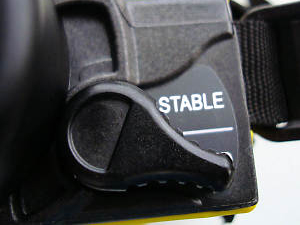 |
|
Click image to enlarge
|
To begin using the S250, the user inserts a CR-123 battery in the waterproof battery compartment. Set the power button
to off and the stabilization switch to LOCKED. Yes, we know you see the label that says "STABLE". The lever is over
the label that says "LOCKED". Next, set the interpupillary distance (IPD) as usual so the view is a single circle.
There should be quite a bit of resistance as you don’t want the IPD to change on you while viewing. The S250 has a very
generous IPD range of 52mm to 75 mm. As described above, the user sets the diopters for each eye.
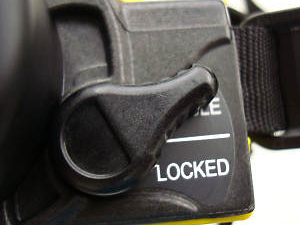 |
|
Click image to enlarge
|
To turn on stabilization, press in the power button so that it turns green, and flip the stabilization lever to STABLE.
The prisms will now scan and stabilize the image as the binocular moves. When you raise the binoculars to your eyes, do
so smoothly, so you don't cause the prisms to lag vertically. The eyecups are rubber and fold down to adjust
between those who wear eyeglasses and those who don’t.
Accessories
The S250 comes with both a neck strap and a hand strap. Both are useful for supporting and controlling the binocular.
The binocular is bulky and weighs nearly 4 lbs., so control is needed to lift and point it. The hand strap can be
attached to either side of the binocular. Rubber armoring with longitudinal ridges also help with the grip.
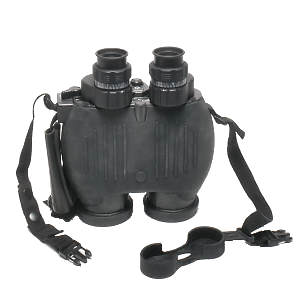 |
|
Click image to enlarge
|
Both a rainguard and tethered objective covers are provided for lens protection. The rainguard can be attached to the
neck strap to prevent loss.
While our prototype was not so supplied, the production models will have replaceable eyepieces, so the supplied daytime
eyepieces can be removed, and optional night vision eyepieces installed.
Fraser Optics’ original plan was to offer either a soft pouch or a hard case. Ours arrived with both, and the pouch fit
inside the case. However, the S250 now comes only with a hard case that is different from the one we received, so we can’t
comment on it until we see one.
Conclusions
The Fraser Optics S250 Stabilized Binocular is definitely the right tool for the right job. While not appropriate for
normal birding, the S250 is superb for all pelagic use including military, whale watching, and fishing. In the air, it
is the best choice for surveillance, search and rescue, and scouting. On the ground, surveillance, hawk watches, and
viewing distant wildlife are prime uses. They are available in three colors: yellow, black, and tan.
Buying
Buy Fraser Optics S250 Image Stabilized Binoculars